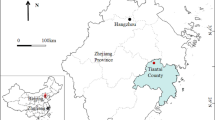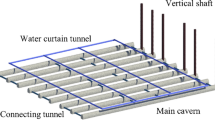Abstract
The Heidong Cavern Group of China includes 21 large-scale caverns that have remained stable for 1400 years. Cavern No. 5 of the Heidong Cavern Group is characterized by an unsupported span of up to 92 m, which is considered to be the largest span in a single underground artificial rock cavern. Cavern No. 5 may have gone through a period during which it was the only cavern and a period during which it had adjacent caverns; recent investigations have proved that Cavern No. 5 is suffering from considerably serious partial damage. The factors affecting the stability of Cavern No. 5, including waste rock accumulations, rock mass structures, surrounding rock quality, and cavern structures, were analyzed to prevent further damage and analyze the influence of the existence of adjacent caverns on the stability of Cavern No. 5. The numerical analysis software MIDAS GTS (Geotechnical and tunnel analysis system) was used to simulate and compare the stability of Cavern No. 5 under the single-cavern and adjacent-cavern cases. Research proves that when this cavern is independently considered and the remaining caverns are excluded, the arched roof structure is considerably favorable to ensure the cavern’s stability and the horizontal compressive stress of the roof becomes approximately equivalent to the vertical tensile stress. The horizontal forces generated by the cavern’s inclined roof contribute to the cavern’s stability. The horizontal compressive stress area of the roof and the effect of the arched structure decrease when adjacent caverns are present, causing the roof to become prone to tensile failure. These results provide a reference for modern underground engineering construction and a theoretical basis for long-term protection of the large and ancient Heidong Caverns.
















Similar content being viewed by others
References
Antonaki N, Abdoun T, Sasanakul I (2018) Centrifuge tests on comixing of mine tailings and waste rock. J Geotech Geoenviron Eng 144(1):04017099. https://doi.org/10.1061/(ASCE)GT.1943-5606.0001783
Bi ZW, Ding DX (2004) Methods and progress in reliability analysis of underground engineering. J Undergr Space Eng (Chinese) 24(4):522–525
Chaudhuri RA, Xie MS (2015) On three-dimensional asymptotic solution, and applicability of Saint–Venant’s principle to pieshaped wedge and end face (of a semi-infinite plate) boundary value problems. Eng Fract Mech 142(7):93–107. https://doi.org/10.1016/j.engfracmech.2015.04.032
Deng XL, Li LH, Tan YF, Huang BX, Yang Z, Guo G, Li T (2018) Stability of large-scale rock cavern complex at the 800-year Feifengyan quarry. In: Proc. GeoShanghai 2018 int. conf.: rock mech. rock eng., GSIC 2018. Springer, Singapore
Gu DZ, Huang DC (1979) Classification of rock mass structure and determination of its mass coefficient. Hydrogeol Eng Geol (Chinese) 2:8–13
Hans R, Ora R, Anna RR (2018) Factfulness: ten reasons we’re wrong about the world—and why things are better than you think. Macmillan, Anchorage
He WT, Shang YJ, Sun YL, Li LH, Yang ZF (2016) Insight of the environmental awareness on waste rock disposal at Heidong Quarry dated 1000 years ago in SE China. Environ Earth Sci 75:163. https://doi.org/10.1007/s12665-015-4984-4
He WT (2016) Engineering geomechanics based analysis for large scale ancient artificial caverns: a case study of the Heidong Caverns in Tiantai County, China [in Chinese]. Ph.D. thesis, Institute of Geology and Geophysics, Chinese Academy of Sciences
Jordá-Bordehore L (2017) Stability assessment of natural caves using empirical approaches and rock mass classifications. Rock Mech Rock Eng 50(8):2143–2154. https://doi.org/10.1007/s00603-017-1216-0
Li LH (2005) Study on the mechanism of the millennium completeness of the large ancient underground caverns in Longyou [in Chinese]. Ph.D. thesis, Institute of Geology and Geophysics, Chinese Academy of Sciences
Li LH, Yang ZF, Zhang LQ, Qi SW, Lu M, Zheng J (2005) A discussion on the inclined roof Longyou caverns for engineering sciences. Chin J Rock Mech Eng 02:336–343
Luo ZQ, Xie CY, Zhou JM, Jia N, Liu XM, Xu H (2015) Numerical analysis of stability for mined-out area in multi-field coupling. J Central South Univ 22(2):669–675. https://doi.org/10.1007/s11771-015-2569-8
MIDAS (2005) Handbook of MIDAS GTS, version 260. MIDAS Information Technology China Co., Ltd, Beijing
Oggeri C, Oreste P (2015) Underground quarrying for marble: Stability assessment through modelling and monitoring. Int J Min Sci 1(1):35–42. www.arcjournals.org
Pelizza S, Oreste PP, Peila D, Oggeri C (2000) Stability analysis of a large cavern in Italy for quarrying exploitation of a pink marble. Tunnel Undergr Space Technol 15(4):421–435. https://doi.org/10.1016/S0886-7798(01)00011-6
Shang YJ, Yang ZF, Li LH, Li TB, He WT (2015) Study of the engineering geological conditions and rock mass stability of Heidong large ancient underground caverns. J Jilin Univ (Earth Science Edition) 45(1):214–224
Shang YJ, Li LH, He WT, Zhang LQ, Li TB, Yang ZF (2017) Back analysis of long-term stability of a 92 m span ancient quarrying cavern. J Rock Mech Geotech Eng 17(9):350–363. https://doi.org/10.1016/j.jrmge.2016.12.004
Sun J, Ling JM, Jia G, Zhan YP (2001) Examining the Long-you grottoes in the western land of Zhejiang province from the view point of engineering science. Chin J Rock Mech Eng 20(1):131–133
Swift GM (2000) An examination of stability issues relating to abandoned underground mine works. Ph.D. thesis, Dept. of Civil Engineering, Nottingham University
Talesnick ML, Haztor YH, Tsesarsky M (2001) The elastic deformability and strength of a high porosity, anisotropic chalk. Int J Rock Mech Min Sci 38:543–555. https://doi.org/10.1016/S1365-1609(01)00024-7
Team of Regional Geology Expedition, Brueau of Zhejiang Geology (1978) Expedition Report of Regional Geology (Xianju Sheet, 1:200,000)
Tsesarsky M, Gal E, Machlav E (2013) 3-D global-local finite element analysis of shallow underground caverns in soft sedimentary rock. Int J Rock Mech Min Sci 57:89–99. https://doi.org/10.1016/j.ijrmms.2012.07.034
Waltham AC (1993) Crown hole development in the sandstone caves of Nottingham. Q J Eng Geol 26(4):243–251. https://doi.org/10.1016/0148-9062(94)90881-8
Waltham AC, Swift GM (2004) Bearing capacity of rock over mined cavities in Nottingham. Eng Geol 75(1):15–31. https://doi.org/10.1016/j.enggeo.2004.04.006
Yang ZF, Li LH, Zhang LQ (2005) On back analysis of long-term shear strength of No. 4–2 rock pillar in the No. 4 cavern of Long-you caverns. J Eng Geol 13(1):62–67
Yang ZF, Hu WD, Zhang LQ, Zeng QL, Guo GM, Gao BL (2007) Scientific discoveries of Jinxiu-Huangyan Panlongdong ancient underground cave group and preliminary analysis. J Eng Geol 15(3):322–327
Yang ZF, Yue ZQ, Li LH (2010) Research on science and technology problems of large underground engineering caverns in Longyou Grottoes. Science Press, Beijing
Yang ZF, Gao BL, Zhang LQ (2012a) Xianju feifeng rocks large ancient underground caverns engineering science and technology research. Science Press, Beijing
Yang ZF, Zhang LQ, Zhang ZJ (2012b) Shepan island large ancient underground caverns engineering science and technology research. Science Press, Beijing
Yang ZF, Shang YJ, Li LH, Zhang LQ, Zhang ZJ, Li TB, Zhang W, Xu SS (2013) Long term stability of large span caverns at the 1400-year Heidong quarry. Episodes 36(1):39–46. https://doi.org/10.18814/epiiugs/2013/v36i1/006
Yang ZF, Shang YJ, Zhang LQ, Li LH (2015) Discovery and recognition of scientific values of forty-nine large scale ancient underground engineering in Zhejiang Province. In: Ancient underground opening and preservation: proc. int. symp. sci. prob. long-term preserv. Large-Scale Ancient Underground Eng., pp 309–322
Zhao H, Zheng D, Huang G (2015) Study on formation mechanism of rockfall in Kaiyang phosphate mining area. In: Lollino G et al (eds) Engineering geology for society and territory—volume 2. Springer, Cham. https://doi.org/10.1007/978-3-319-09057-3_178
Zhu JW, Song B, Liu EC, Yang ZF, Zhang LQ, Li LH (2008) Mechanics idea about Longyou Grottoes structure. Rock Soil Mech 29(9):2427–2432
Acknowledgements
The research was supported by the National Natural Science Foundation of China (Grant Nos. 41672321) and Special research project of Shaanxi Provincial Education Department (Project Nos. 16JK1489).
Author information
Authors and Affiliations
Corresponding author
Additional information
Publisher's Note
Springer Nature remains neutral with regard to jurisdictional claims in published maps and institutional affiliations.
Rights and permissions
About this article
Cite this article
Gao, B., Zhang, H., He, W. et al. Stability analysis of Cavern No. 5 with the largest span in Heidong large ancient underground quarry. Environ Earth Sci 79, 273 (2020). https://doi.org/10.1007/s12665-020-09011-5
Received:
Accepted:
Published:
DOI: https://doi.org/10.1007/s12665-020-09011-5




